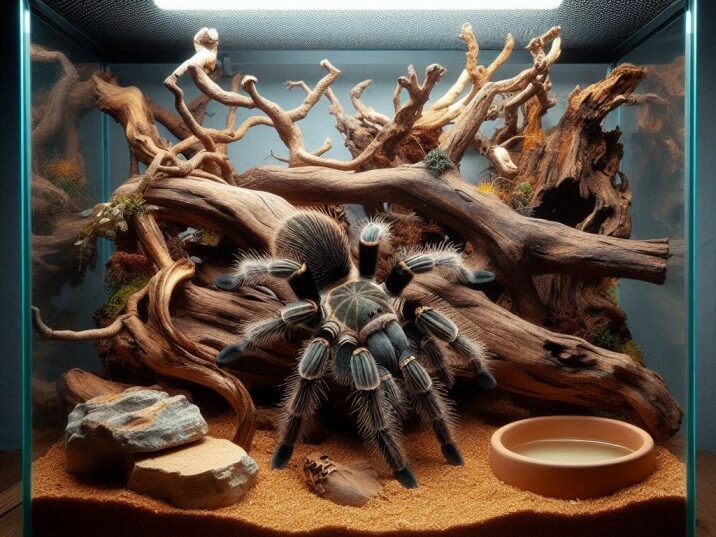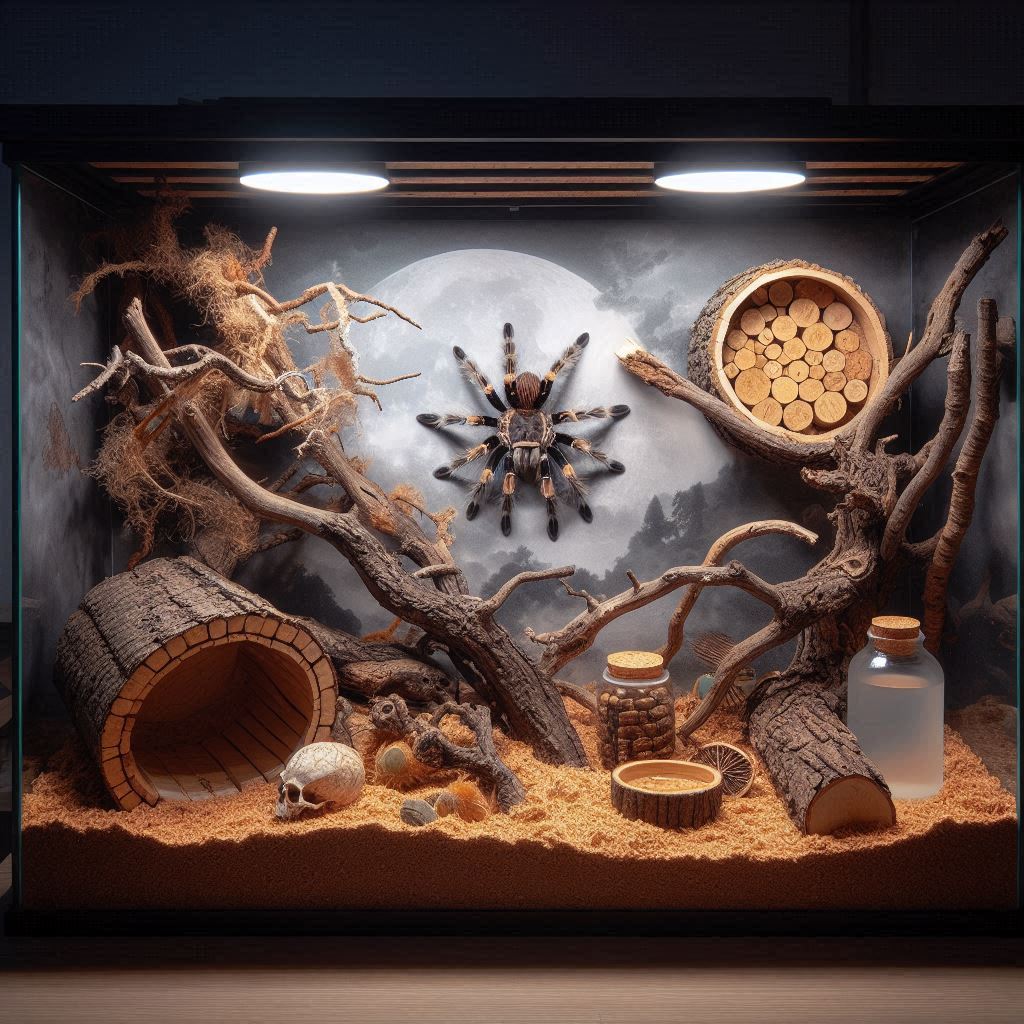Introduction
Table of Contents
Are you fascinated by arboreal tarantulas and planning to keep one as a pet? These intriguing creatures are known for their unique climbing abilities and beautiful colors. To ensure they thrive in captivity, it’s crucial to provide a suitable arboreal tarantula enclosure. In this guide, we’ll walk you through everything you need to know to create the perfect home for your pet tarantula. From choosing the right tank to setting up the ideal environment, we’ve got you covered. Let’s dive in and learn how to make your tarantula feel at home!

Understanding Arboreal Tarantulas
What Are Arboreal Tarantulas?
Arboreal tarantulas are a type of tarantula that primarily lives in trees and other elevated areas in their natural habitats. Unlike terrestrial tarantulas that dwell on the ground, arboreal tarantulas are adapted to life off the ground. They have specialized physical traits that help them climb and live in trees, making their enclosure requirements unique.
Popular Arboreal Tarantula Species
Some of the most popular species of arboreal tarantulas include:
- Gooty Sapphire Ornamental (Poecilotheria metallica)
- Green Bottle Blue (Chromatopelma cyaneopubescens)
- Pink-toe Tarantula (Avicularia avicularia)
These species are known for their vibrant colors and fascinating behaviors, making them a favorite among tarantula enthusiasts.
Setting Up the Perfect Arboreal Tarantula Enclosure
Choosing the Right Enclosure
The first step in creating a suitable arboreal tarantula enclosure is selecting the right tank. Here are some key points to consider:
- Size: A tank size of 12x12x18 inches is ideal for most arboreal tarantulas.
- Material: Glass or acrylic tanks are preferred for their durability and visibility.
- Ventilation: Ensure the tank has proper ventilation to maintain air quality.
Essential Components of the Enclosure
Substrate
The substrate is the material that lines the bottom of the enclosure. For arboreal tarantulas, a substrate that retains moisture and provides a natural feel is ideal. Coconut fiber, peat moss, or a mix of both are great options. The substrate should be at least 2 inches deep to help maintain humidity.
Vertical Climbing Structures
Since arboreal tarantulas love to climb, providing vertical structures like branches, cork bark, and vines is essential. These elements mimic their natural habitat and allow them to exhibit their natural behaviors.
Hiding Spots
Tarantulas need hiding spots to feel secure. Incorporate cork bark tubes, hollow logs, or small artificial caves to give your tarantula a place to retreat.
Water Dish
A shallow water dish is necessary to keep your tarantula hydrated. Ensure the dish is always clean and filled with fresh water.
Temperature and Humidity
Ideal Temperature
Arboreal tarantulas thrive in temperatures between 75-85°F. Use a thermometer to monitor the temperature inside the enclosure and adjust as needed using a heat mat or lamp if necessary.
Maintaining Humidity
These tarantulas require humidity levels of 70-80%. To maintain proper humidity, mist the enclosure regularly and ensure the substrate remains slightly moist. A hygrometer can help you keep track of humidity levels.
Caring for Your Arboreal Tarantula
Feeding
Arboreal tarantulas primarily feed on live insects such as crickets, roaches, and mealworms. Juvenile tarantulas should be fed every 2-3 days, while adults can be fed once a week. Make sure the prey size is appropriate for your tarantula to avoid any potential harm.
Handling
While tarantulas can be fascinating pets, they are generally not meant to be handled frequently. Handling can cause stress and pose risks to both you and the tarantula. If handling is necessary, do so gently and minimally.
Cleaning the Enclosure
Regular maintenance of the arboreal tarantula enclosure is important for your pet’s health. Remove any uneaten prey within 24 hours, clean the water dish regularly, and spot-clean any waste. A full enclosure cleaning can be done every 3-6 months.
Common Problems and Solutions
Molting Issues
Tarantulas molt to grow, shedding their old exoskeleton. During this time, they are very vulnerable. Ensure the enclosure is humid and avoid disturbing your tarantula. If your tarantula is struggling to molt, increase the humidity slightly and provide a quiet environment.
Health Concerns
Keep an eye out for signs of illness such as lethargy, loss of appetite, or abnormal behavior. If you notice any issues, consult a veterinarian who specializes in exotic pets.
Table of Information
| Component | Description |
|---|---|
| Tank Size | 12x12x18 inches |
| Substrate | Coconut fiber or peat moss, 2 inches deep |
| Climbing Structures | Branches, cork bark, vines |
| Hiding Spots | Cork bark tubes, hollow logs, artificial caves |
| Water Dish | Shallow, clean, and filled with fresh water |
| Ideal Temperature | 75-85°F |
| Humidity Level | 70-80%, maintained by misting and moist substrate |
| Feeding Frequency | Juveniles: every 2-3 days; Adults: once a week |
Conclusion
Creating the perfect arboreal tarantula enclosure is essential for the health and well-being of your pet. By understanding their natural habitat and needs, you can provide an environment where your tarantula can thrive. Remember to keep the enclosure clean, maintain proper temperature and humidity, and provide ample climbing structures. With the right care, your arboreal tarantula will be a fascinating and rewarding pet for years to come.
FAQs
1. What size tank do I need for an arboreal tarantula? A 12x12x18 inch tank is ideal for most arboreal tarantulas.
2. How often should I feed my arboreal tarantula? Juvenile tarantulas should be fed every 2-3 days, while adults can be fed once a week.
3. What should I use for substrate in an arboreal tarantula enclosure? Coconut fiber or peat moss are excellent choices for substrate, providing moisture retention and a natural feel.
4. How can I maintain the humidity in the enclosure? Maintain humidity by misting the enclosure regularly and ensuring the substrate remains slightly moist.
5. Can I handle my arboreal tarantula? While it’s possible to handle tarantulas, it’s generally not recommended as it can cause stress and pose risks to both you and the tarantula.

